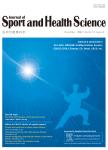Twelve weeks of dance exergaming in overweight and obese adolescent girls:Transfer effects on physical activity,screen time,and self-efficacy
Twelve weeks of dance exergaming in overweight and obese adolescent girls: Transfer effects on physical activity, screen time, and self-efficacy作者机构:Pennington Biomedical Research CenterBaton RougeLA 70808USA
出 版 物:《Journal of Sport and Health Science》 (运动与健康科学(英文))
年 卷 期:2017年第6卷第1期
页 面:4-10,127页
核心收录:
学科分类:0403[教育学-体育学] 04[教育学] 1002[医学-临床医学] 100202[医学-儿科学] 10[医学]
基 金:AES and PTK are supported,in part,by the U54 GM104940 grant from the National Institute of General Medical Sciences of the US National Institutes of Health,which funds the Louisiana Clinical&Translational Science Center PTK is supported,in part,by the Marie Edana Corcoran Endowed Chair in Pediatric Obesity and Diabetes partially supported by Nutrition Obesity Research Center Grant#P30DK072476 entitled“Nutritional Programming:Environmental and Molecular Interactions”
主 题:Active video games Leisure activity Motivation Screen time Self-efficacy Television
摘 要:Background: Given the low levels of physical activity(PA) among adolescent girls in the US, there is a need to identify tools to motivate increased PA. Although there is limited evidence that adolescents transfer PA from one context to another, exergames(i.e., video games that require gross motor activity) may act as a gateway to promote overall PA outside game play. The purpose of this study was to examine potential transfer effects(i.e., influences on external behaviors and psychological constructs) of a 12-week exergaming intervention on adolescent girls PA, screen time,and self-efficacy toward PA, as well as the intrinsic motivation of ***: Participants were 37 girls aged 14–18 years(65% African American, 35% white) who were overweight or obese(body mass index ≥ 85 th percentile) and were recruited from the community via school, physicians, news media, and social media websites. Adolescents were randomly assigned to a 12-week group exergaming intervention(thirty-six 60 min sessions of group-based dance exergaming in a research laboratory using Kinect for Xbox360(Microsoft Corporation, Redmond, WA, USA)) or to a no-treatment control group. Outcome variables included objectively measured PA(total) and self-reported leisure-time PA(discretionary time only) 1 week before vs. 1 week after the intervention; selected type and intensity of PA when placed in a gym setting for 30 min(cardio free choice); screen time; self-efficacy toward PA; and intrinsic motivation toward ***: Attendance at the exergaming sessions was high(80%). Compared with the control group, the intervention group self-reported an increase in PA(p = 0.035) and fewer hours watching television or videos(p = 0.01) after the intervention, but there were no significant differences in sedentary, light, moderate, or vigorous PA measured by accelerometry. The intervention group significantly improved self-efficacy toward PA(p = 0.028). The intervention group highly rated intri




